
The Little Microcars That Could (Almost)
I confessed in an article recently that, despite my aversion to ‘cutesy cars’, I am madly in lust with the Fiat 500, both classic and moderns iterations. The Fiat 500, along with the Mini Cooper, and to an extent, the Volkswagen Beetle, are symbols of classic micro-cardome, harkening back to an era when seeing small cars was a shock to the retinas so utterly accustomed to yacht-sized behemoths with towering fins and grilles the size of small eastern European Soviet satellite states.
While there is no shortage of modern microcar equivalents, including the Smart Car and the Scion IQ, the environment surrounding them has shifted. Modern mindset has come to embrace the micromachine in a way never before accepted, during the reign of American steel and luxury. Cars of eras past weighed as much as some Olympic-sized swimming pools, with massive convertible hydraulic systems and legroom enough for all seven of Snow White’s dwarves to comfortably river dance.
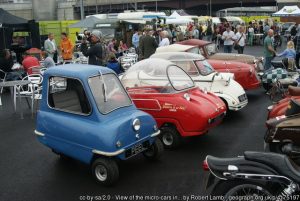 I digress. Because of this mindset, however, of the bigger is better, power, steel, and strength mentality of the 20th-century automotive industry, most microcars were essentially doomed to failure. Am I here to say that’s an entirely terribly fate, not necessarily. Given that the most extensive safety features on most of the cars from the last century were their bulk, weight, and size, classic microcars were undeniably unsafe, the equivalent of taking a carnival ride and throwing it into commuter traffic with your kid in the passenger seat. But safety concerns aside, (and in the hindsight of 21st-century regulation, it takes a major effort to do so,) it’s hard not to respect, and in some cases, love, the microcars with which we might be less familiar, the strangely shaped and quirky, the underpowered and slow.
I digress. Because of this mindset, however, of the bigger is better, power, steel, and strength mentality of the 20th-century automotive industry, most microcars were essentially doomed to failure. Am I here to say that’s an entirely terribly fate, not necessarily. Given that the most extensive safety features on most of the cars from the last century were their bulk, weight, and size, classic microcars were undeniably unsafe, the equivalent of taking a carnival ride and throwing it into commuter traffic with your kid in the passenger seat. But safety concerns aside, (and in the hindsight of 21st-century regulation, it takes a major effort to do so,) it’s hard not to respect, and in some cases, love, the microcars with which we might be less familiar, the strangely shaped and quirky, the underpowered and slow.
In some ways, (again, not safety,) they were ahead of their time, better on gas, lighter and more efficient, and because of that, now seems as good a time as any to pay them the homage they deserve.
The 1953 Allard Clipper Microcar – If you thought that Corvette sales in 1953 were low, (and they were), check out the three-wheeled Allard Clipper Microcar, produced in a run of just around 20, between 1953 – 1955. In terms of innovation that preceded its time, the Allard Clipper is a poster child, as it was the first car to ever come out of Britain with a ‘plastic body’ (read: fiberglass) – a standard for many car companies around the world today. It produced a laughable 8bhp from the 2 cylinder engine, a far cry from most vacuum cleaners currently on the market.
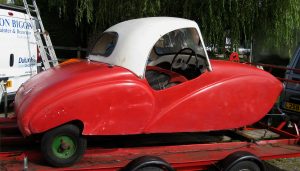 Incredibly enough, this car sat three grown adults, (with a bench seat, nonetheless,) and could fit two children in the ‘dickey seats’ that opened out of out the trunk. One could argue that this car was the predecessor for the game ‘how many people can we fit into a Smart Car?’ Naturally, seatbelts didn’t factor in. And, despite its lightweight and small engine, making it one of the most economical cars of the time, neither did cooling or general steering ability. Issues with overheating and the drive shaft systems, as well as major financial obstacles, lead to the car’s ultimate demise in 1955.
Incredibly enough, this car sat three grown adults, (with a bench seat, nonetheless,) and could fit two children in the ‘dickey seats’ that opened out of out the trunk. One could argue that this car was the predecessor for the game ‘how many people can we fit into a Smart Car?’ Naturally, seatbelts didn’t factor in. And, despite its lightweight and small engine, making it one of the most economical cars of the time, neither did cooling or general steering ability. Issues with overheating and the drive shaft systems, as well as major financial obstacles, lead to the car’s ultimate demise in 1955.
And, because we simply must point out the elephant in the room, (since it’s definitely not fitting in the car), it’s hard to be terribly surprised that this unwieldy little monster wasn’t an overnight commercial success. With curves carved into the sides like some sort of ancient Greek potting technique, the design feels better suited to the Dumbo ride at Disney, (that might be because of the nose), than the streets of any major city. I get the feeling that if an eighteen-wheeler drove past, it might suddenly become airborne. (It is cooler up there, perhaps the car would have worked better.) But, despite the unmanageable obstacles it faced, the Allard Clipper Microcar is undeniably a feat of engineering, and a turning point in history, and I, for one, am cheering it on. Or perhaps pushing it on. Solidarity isn’t worth any horsepower.
FMR Tg500
Let’s talk about bugs. Not Volkswagen bugs, but National Geographic for-the-love-of-God-get-out-of-my-sleeping-bag insect kind of bugs. Let’s talk about bugs, because there is no way that the FMR Tg500 was not directly modeled on a beetle accidentally stuck in the shower drain. It looks like a six-legged, exoskeleton-ed beastie.
Perhaps I’m being unfair. After all, I don’t actually dislike the style – especially rocking the two-tone. It just happens to have a ringing stylistic familiarity to the lesser of my favorite species on earth.
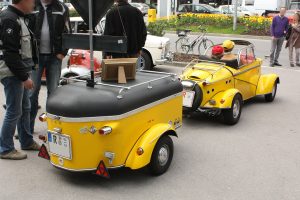 But, apparently not everyone felt the same way. (Either that or there were a lot of entomologists coming into the field between 1958 and 1961). In three years of production, there were 320 made, available in bubble-top coupe, convertible, or roadster. FMR, whose full name would make my spell-check head for the hills of New Mexico to make meth, based the four-wheel Tg500 on the Messerschmitt Kabinenroller monocoque, a platform otherwise used for three-wheelers.
But, apparently not everyone felt the same way. (Either that or there were a lot of entomologists coming into the field between 1958 and 1961). In three years of production, there were 320 made, available in bubble-top coupe, convertible, or roadster. FMR, whose full name would make my spell-check head for the hills of New Mexico to make meth, based the four-wheel Tg500 on the Messerschmitt Kabinenroller monocoque, a platform otherwise used for three-wheelers.
To throw a little more party into the mix, the Tg500, unofficially standing for ‘Tiger’, had tandem seating, lining up passengers longitudinally, which helped centralize the mass of the car, which along with lower center of gravity and lower weight, helped to provide good handling, as well as allowing the car to be exported without needing an alternative drive option. Another rarely discussed perk of the seating is that if you’re ever stuck in traffic you can close your eyes and pretend you’re the Red Baron.
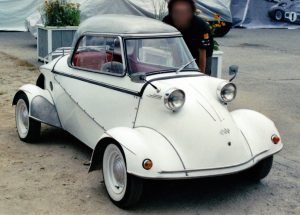 The two-cylinder two-stroke engine makes the Allard Clipper Microcar look like a Honda Fit at Bonneville, producing an awe-inspiring 19.2 horsepower, with a top speed of 78 miles per hour, and a record-breaking 0 – 60 time of, wait for it, keep waiting, 28 seconds!
The two-cylinder two-stroke engine makes the Allard Clipper Microcar look like a Honda Fit at Bonneville, producing an awe-inspiring 19.2 horsepower, with a top speed of 78 miles per hour, and a record-breaking 0 – 60 time of, wait for it, keep waiting, 28 seconds!
The little Tiger that almost could is known for one major record-setting, however. In 2013 at the Bruce Weiner Microcar Museum auction, it blew the expected $125,000 to $150,000 sale out of the water, started at $140,000 and selling for $322,000, the most ever spent on a microcar in all of history. It is largely attributed to the car’s speed and power output, laughable by today’s standard, that the car was able to fetch such an enormous sum.
Nearly half of the cars produced are still around today, and I must say, without a hint of sarcasm, I hope they’re all being treated so well.
1961 Taylor-Dunn Trident
Since we’re going for a full menagerie here, I have to say that this beautiful specimen reminds me of a wise old basset hound in some Disney talking animals on a heartfelt adventure movie, with its droopy, but knowing eyes, and the distance expression, as it recalls the simple joy of its youth. Whether you subscribe to the school of squeeze-ends-meet metaphors or not, there’s no denying that this car has an expressive front end, a necessary feature when you’re a square on wheels.
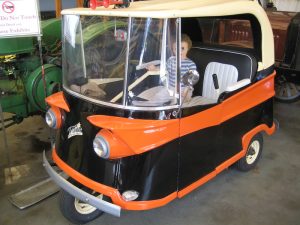 And the Taylor-Dunn Trident comes from humble origins. In the late 1940s, R.D. Taylor Sr. and Fred Dunn joined forces in California to help produce motorized farm equipment, creating Taylor-Dunn Manufacturing in 1949. In 1951 they produced their first electric truck, (eat your heart out Porsche Spyder 918), and began selling them to local farmers. By 1955 they produced the ‘PG’ a three-wheeled electric car, with the intention of local travel. The PG was fully equipped with headlights, taillights and tiller steering. In 1959 they produced the ‘R’ Trident, adding the luxury of turn signals to the earlier model. They would produce this version until 1963.
And the Taylor-Dunn Trident comes from humble origins. In the late 1940s, R.D. Taylor Sr. and Fred Dunn joined forces in California to help produce motorized farm equipment, creating Taylor-Dunn Manufacturing in 1949. In 1951 they produced their first electric truck, (eat your heart out Porsche Spyder 918), and began selling them to local farmers. By 1955 they produced the ‘PG’ a three-wheeled electric car, with the intention of local travel. The PG was fully equipped with headlights, taillights and tiller steering. In 1959 they produced the ‘R’ Trident, adding the luxury of turn signals to the earlier model. They would produce this version until 1963.
I love this car for a whole slew of reasons, and most of them probably wouldn’t stand up in a debate. (Neither would I, as I am not a masochist nor glutton for punishment.) But my most favorite element of this geometrical slice of history is that this one horsepower, (you read that right,) box on wheels, with a high-end output of 16 miles per hour, was electric. It was an electric microcar in a time when you might have better luck fitting in if you wore a hammer and sickle across your chest. It went so obtusely against the status quo of mid-century American cars that it has all but faded from history, a blip in a decade when so much more would remain so permanent. For a car that weighed all of 730 pounds and couldn’t best a cheetah cub, the Taylor-Dunn Trident had some guts.
One of the beautiful elements of the automotive industry is its vastness. The world changes and cars change. Cars change and the world changes. I don’t think I hyperbolize when I say that modern history as we know it is inexorably entwined with that of the motorcar, in whatever iteration you fancy. But not all cars fall neatly into their time or place in history. Sometimes, be it for design or innovation or sheer creative thinking, cars come ahead of their time. They stand out from the crowd, and are often shushed for it, the round pegs in square holes of their era. (Or perhaps, in the case of the Trident, square cars in the gas-guzzling holes of their era.)
The microcars of yesterday were gallant warriors, and though they may not have belonged to their own time, their descents certainly do. For all that they are little, under-powered, and ultimately strange beasties, these microcars, and the others like them through time, make for a macro piece of automotive history.
Image top left by Robert Lamb via Creative Commons.
Image top right selected from Creative Commons via Wikipedia.
Image middle right selected from Creative Commons via Wikipedia.
Image middle left selected from Creative Commons via Wikipedia.
Image bottom left by John LLoyd via Creative Commons.

